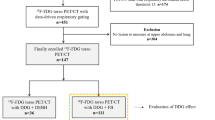Abstract
Purpose
Positron emission tomography/computed tomography (PET/CT) is an important tool for tumor staging or treatment response evaluation, especially for lung tumors. However, the captured static PET image could be blurry due to patients' free breathing, resulting in decreased image quality and incorrect quantitative values. This study aimed to evaluate whether the Q.Static scan mode with the novel PET list data-driven gated (DDG) technique decreases the lesion blurring problems in the PET/CT images of patients with lung cancer.
Methods
Data of 194 patients with lung tumors were retrospectively reviewed. DDG Q.Static scan mode was set up in three beds to cover the whole chest and the upper abdomen in the routine PET/CT scans and was activated automatically when sensing significant respiratory motion. Routine reconstruction algorithm was applied for data analysis. Only the lesions in the motion-corrected areas were measured and calculated for statistics.
Results
Among the 194 patients, 124 had at least one bed that activated the DDG Q.Static procedure. However, only 49 out of the 124 patients showed lesions in their activated beds. Compared with the non-corrected data, the DDG Q.Static data showed improved accuracy with increased SUVmax and SUVmean of 8.52% (9.20 ± 5.42 to 9.74 ± 5.42) and 8.65% (6.11 ± 3.68 to 6.48 ± 3.68), respectively. In addition, metabolic tumor volume was reduced from 6.54 ± 8.58 to 5.55 ± 7.33 (14.79% reduction). For subjective image quality, the DDG Q.Static data scored higher than the non-corrected data.
Conclusion
This study showed that the quantitative values and image quality were improved after the correction. Therefore, the DDG Q.Static technique is an effective method to correct motion artifacts in PET/CT scans.



Similar content being viewed by others
References
Hochhegger, B., et al. (2015). PET/CT imaging in lung cancer: Indications and findings. Jornal Brasileiro de Pneumologia, 41(3), 264–274.
Greenspan, B. S. (2017). Role of PET/CT for precision medicine in lung cancer: Perspective of the Society of Nuclear Medicine and Molecular Imaging. Translational Lung Cancer Research, 6(6), 617–620.
Beyer, T., et al. (2000). A combined PET/CT scanner for clinical oncology. Journal of Nuclear Medicine, 41(8), 1369–1379.
Ambrosini, V., et al. (2012). PET/CT imaging in different types of lung cancer: An overview. European Journal of Radiology, 81(5), 988–1001.
Erdi, Y. E., et al. (2004). The CT motion quantitation of lung lesions and its impact on PET-measured SUVs. Journal of Nuclear Medicine, 45(8), 1287–1292.
Nehmeh, S. A., et al. (2002). Effect of respiratory gating on quantifying PET images of lung cancer. Journal of Nuclear Medicine, 43(7), 876–881.
Nehmeh, S. A., et al. (2003). Reduction of respiratory motion artifacts in PET imaging of lung cancer by respiratory correlated dynamic PET: Methodology and comparison with respiratory gated PET. Journal of Nuclear Medicine, 44(10), 1644–1648.
Chang, G., Chang, T., Pan, T., Clark, J. W., & Mawlawi, O. R. (2010). Joint correction of respiratory motion artifact and partial volume effect in lung/thoracic PET/CT imaging. Medical Physics, 37(12), 6221–6232. https://doi.org/10.1118/1.3512780
Pépin, A., Daouk, J., Bailly, P., Hapdey, S., & Meyer, M. E. (2014). Management of respiratory motion in PET/computed tomography: The state of the art. Nuclear Medicine Communications, 35(2), 113–122. https://doi.org/10.1097/MNM.0000000000000048,Feb
Huang, T. C., Wang, Y. C., Chiou, Y. R., & Kao, C. H. (2014). Respiratory motion reduction in PET/CT using abdominal compression for lung cancer patients. PLoS ONE, 9(5), e98033.
Liu, C., Alessio, A. M., & Kinahan, P. E. (2011). Respiratory motion correction for quantitative PET/CT using all detected events with internal—External motion correlation. Medical Physics, 38(5), 2715–2723.
Kawano, T., Ohtake, E., & Inoue, T. (2008). Deep-inspiration breath-hold PET/CT of lung cancer: Maximum standardized uptake value analysis of 108 patients. Journal of Nuclear Medicine, 49(8), 1223–1231. https://doi.org/10.2967/jnumed.107.049296
Walker, M. D., Bradley, K. M., & McGowan, D. R. (2018). Evaluation of principal component analysis-based data-driven respiratory gating for positron emission tomography. British Journal of Radiology, 91(1085), 20170793.
Walker, M. D., Morgan, A. J., Bradley, K. M., & McGowan, D. R. (2019). Evaluation of data-driven respiratory gating waveforms for clinical PET imaging. EJNMMI Research, 9(1), 1.
Thielemans, K., Rathore, S., Engbrant, F., & Razifar, P. (2011). Device-less gating for PET/CT using PCA. In IEEE nucl. sci. symposium conference record (pp. 3904–3910). IEEE
Lamare, F., Cresson, T., Savean, J., Cheze Le Rest, C. C., Reader, A. J., & Visvikis, D. (2007). Respiratory motion correction for PET oncology applications using affine transformation of list mode data. Physics in Medicine & Biology, 52(1), 121–140.
Liu, C., Pierce, L. A., Alessio, A. M., & Kinahan, P. E. (2009). The impact of respiratory motion on tumor quantification and delineation in static PET/CT imaging. Physics in Medicine and Biology, 54(24), 7345–7362. https://doi.org/10.1088/0031-9155/54/24/007
Meier, J., & Mawlawi, O. (2018). Impact of personalized selection of Quiescent phase gating parameters with Q. Static PET/CT imaging. Society of Nuclear Medicine.
Author information
Authors and Affiliations
Corresponding author
Ethics declarations
Conflict of interest
None.
Rights and permissions
About this article
Cite this article
Chen, YL., Yang, BH., Shih, IL. et al. Evaluation of PET List Data-Driven Gated Motion Correction Technique Applied in Lung Tumors. J. Med. Biol. Eng. 42, 382–387 (2022). https://doi.org/10.1007/s40846-022-00719-2
Received:
Revised:
Accepted:
Published:
Issue Date:
DOI: https://doi.org/10.1007/s40846-022-00719-2




